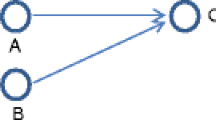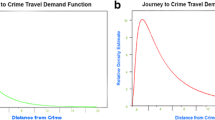Abstract
Model-based reasoning approaches can be used to formalize and analyze (informal) theories from the field of criminology, to help gain more insight in criminological phenomena that were not clear based on just the informal theory. The analysis of the displacement of crime is an important research interest in criminological research. In this chapter, an agent-based simulation model of crime displacement is presented, which can be used not only to simulate the spatiotemporal dynamics of crime, but also to analyze and control those dynamics. Methods are used that are aimed at developing intelligent systems that monitor human-related processes and provide appropriate support. More specifically, an explicit domain model of crime displacement has been developed, and model-based reasoning techniques are applied to the domain model, in order to analyze which environmental circumstances result in which crime rates, and to determine which support measures are most appropriate. The model can be used as an analytical tool for researchers and policy makers to perform thought experiments, that is, to shed more light on the process under investigation, and possibly improve existing policies (e. g., for surveillance).
Access this chapter
Tax calculation will be finalised at checkout
Purchases are for personal use only
Similar content being viewed by others
Abbreviations
- AI:
-
artificial intelligence
- AmI:
-
ambient intelligence
- CA:
-
cellular automata
- GIS:
-
geographical information system
References
Merriam-Webster: http://www.merriam-webster.com/dictionary/criminology
C. Gerritsen: Caught in the Act: Investigating Crime by Agent-Based Simulation, Ph.D. Thesis. (VU Univ., Amsterdam 2010)
L. Liu, J. Eck (Eds.): Artificial Crime Analysis Systems: Using Computer Simulations and Geographic Information Systems (Information Science Reference, Hershey 2008)
N. Malleson, P. Brantingham: Prototype burglary simulations for crime reduction and forecasting, Crime Patterns Anal. 2(1), 47–66 (2008)
L.E. Cohen, M. Felson: Social change and crime rate trends: A routine activity approach, Am. Sociol. Rev. 44, 588–608 (1979)
D.T. Herbert: The Geography of Urban Crime (Longman, Harlow 1982)
L.W. Sherman, P.R. Gartin, M.E. Buerger: Hot spots of predatory crime: Routine activities and the criminology of place, Criminology 27, 27–55 (1989)
T. Bosse, C. Gerritsen: Social simulation and analysis of the dynamics of criminal hot spots, J. Artif. Soc. Soc. Simul. (2010), doi:10.18564/jasss.1498
T. Bosse, C. Gerritsen, M. Hoogendoorn, S.W. Jaffry, J. Treur: Agent-based versus population-based simulation of displacement of crime: A comparative study, Web Intell. Agent-Syst. Int. J. 9, 147–160 (2011)
P.L. Brantingham, U. Glässer, K. Singh, M. Vajihollahi: Mastermind: Modeling and Simulation of Criminal Activity in Urban Environments, Technical Report SFU-CMPTTR-2005-01 (Simon Fraser Univ., Burnaby 2005)
D. Reis, A. Melo, A.L.V. Coelho, V. Furtado: Towards optimal police patrol routes with genetic algorithms. In: Intelligence and Security Informatics, ed. by S. Mehrotra, D.D. Zeng, H. Chen, B. Thuraisingham, F. Wang (Springer, Berlin, Heidelberg 2006) pp. 485–491, LNCS 3975
K. Hayslett-McCall, F. Qui, K.M. Curtin, B. Chastain, J. Schubert, V. Carver: The simulation of the journey to residential burglary. In: Artificial Crime Analysis Systems: Using Computer Simulations and Geographic Information Systems, ed. by L. Liu, J. Eck (Information Science Reference, Hershey 2008) pp. 281–300
L. Liu, X. Wang, J. Eck, J. Liang: Simulating crime events and crime patterns in RA/CA model. In: Geographic Information Systems and Crime Analysis, ed. by F. Wang (Idea Group, Singapore 2005) pp. 197–213, in RA
E.R. Groff: The Geography of Juvenile Crime Place Trajectories, Ph.D. Thesis (University of Maryland, College Park 2005)
H. Elffers, P. van Baal: Spatial Backcloth is not that important in simulation research: An illustration from simulating perceptual deterrence. In: Artificial Crime Analysis Systems, ed. by L. Liu, J.E. Eck (IGI Global, Hershey 2008) pp. 19–34
E. Aarts, R. Collier, E. van Loenen, B. de Ruyter (Eds.): Ambient intelligence: Proc. First Eur. Symp. EUSAI 2003, Lect. Notes Comput. Sci., Vol. 2875 (Springer, Berlin, Heidelberg 2003)
E. Aarts, R. Harwig, M. Schuurmans: Ambient intelligence. In: The Invisible Future, ed. by P. Denning (McGraw Hill, New York 2001) pp. 235–250
G. Riva, F. Vatalaro, F. Davide, M. Alcañiz (Eds.): Ambient Intelligence (IOS, Amsterdam 2005)
T. Bosse, M. Hoogendoorn, M.C.A. Klein, R. van Lambalgen, P.P. van Maanen, J. Treur: Incorporating human aspects in ambient antelligence and smart environments. In: Handbook of Research on Ambient Intelligence and Smart Environments: Trends and Perspectives, ed. by F. Mastrogiovanni, N.Y. Chong (IGI Global, Hershey 2011) pp. 128–164
T. Bosse, F. Both, C. Gerritsen, M. Hoogendoorn, J. Treur: Methods for model-based reasoning within agent-based ambient intelligence applications, Know. Based Syst. J. 27, 190–210 (2012)
T. Bosse, R. Duell, M. Hoogendoorn, M.C.A. Klein, R. van Lambalgen, A. van der Mee, R. Oorburg, A. Sharpanskykh, J. Treur, M. de Vos: An adaptive personal assistant for support in demanding tasks, Lect. Notes Comput. Sci. 5638, 3–12 (2009), Proc. 4th Int. Conf. Augmented Cognition and 13th Int. Conf. Human–Computer Interaction, HCI’09 (Springer, Berlin, Heidelberg)
D.J. Green: Realtime compliance management using a wireless realtime pillbottle - A report on the pilot study of SIMPILL, Proc. Int. Conf. eHealth, Telemedicine and Health, Med-e-Tel’05, Luxemburg (2005)
C.D. Wickens: Situation awareness and workload in aviation, Curr. Directions Psychol. Sci. 11(4), 128–133 (2002)
S. Baron-Cohen: Mindblindness (MIT Press, Cambridge 1995)
J.E. Eck, S. Chainey, J.G. Cameron, M. Leitner, R.E. Wilson: Mapping Crime: Understanding Hot Spots (U.S. Department of Justice, Washington 2005), http://www.ojp.usdoj.gov/nij/pubs-sum/209393.htm
W. Skogan: Fear of crime and neighborhood change. In: Communites and Crime, Crime and Justice, Vol. 8, ed. by A.J. Reiss Jr., M. Tonry (Univ. Chicago Press, Chicago 1986) pp. 203–229
T. Bosse, C. Gerritsen: An agent-based framework to support crime prevention, Proc. 9th Int. Conf. Auton. Agents Multi-Agent Syst., ed. by W. van der Hoek, G.A. Kaminka, Y. Lespérance, M. Luck, S. Sen (ACM, Toronto 2010) pp. 525–532
T. Bosse, C. Gerritsen: Comparing crime prevention strategies by agent-based simulation, Proc. 9th IEEE/WIC/ACM Int. Conf. Intell. Agent Technol., IAT’09 (IEEE CS, 2009) pp. 491–496
T. Bosse, C.M. Jonker, L.J. van der Meij Treur: A language and environment for analysis of dynamics by simulation, Int. J. Artif. Intell. Tools 16(3), 435–464 (2007)
S. Brand, R. Price: The Economic and Social Costs of Crime, Research Study 217 (Home Office, London 2000)
Acknowledgements
This work previously appeared as: T. Bosse, C. Gerritsen: A model-based reasoning approach to prevent crime, Stud. Comput. Intell. 314159–177 (2010), Proc. Int. Conf. Model-Based Reason. Sci. Technol., MBR’09, ed. by L. Magnani, W. Carnielli
Author information
Authors and Affiliations
Corresponding author
Editor information
Editors and Affiliations
Rights and permissions
Copyright information
© 2017 Springer-Verlag Berlin Heidelberg
About this chapter
Cite this chapter
Gerritsen, C., Bosse, T. (2017). Model-Based Reasoning in Crime Prevention. In: Magnani, L., Bertolotti, T. (eds) Springer Handbook of Model-Based Science. Springer Handbooks. Springer, Cham. https://doi.org/10.1007/978-3-319-30526-4_50
Download citation
DOI: https://doi.org/10.1007/978-3-319-30526-4_50
Publisher Name: Springer, Cham
Print ISBN: 978-3-319-30525-7
Online ISBN: 978-3-319-30526-4
eBook Packages: EngineeringEngineering (R0)




